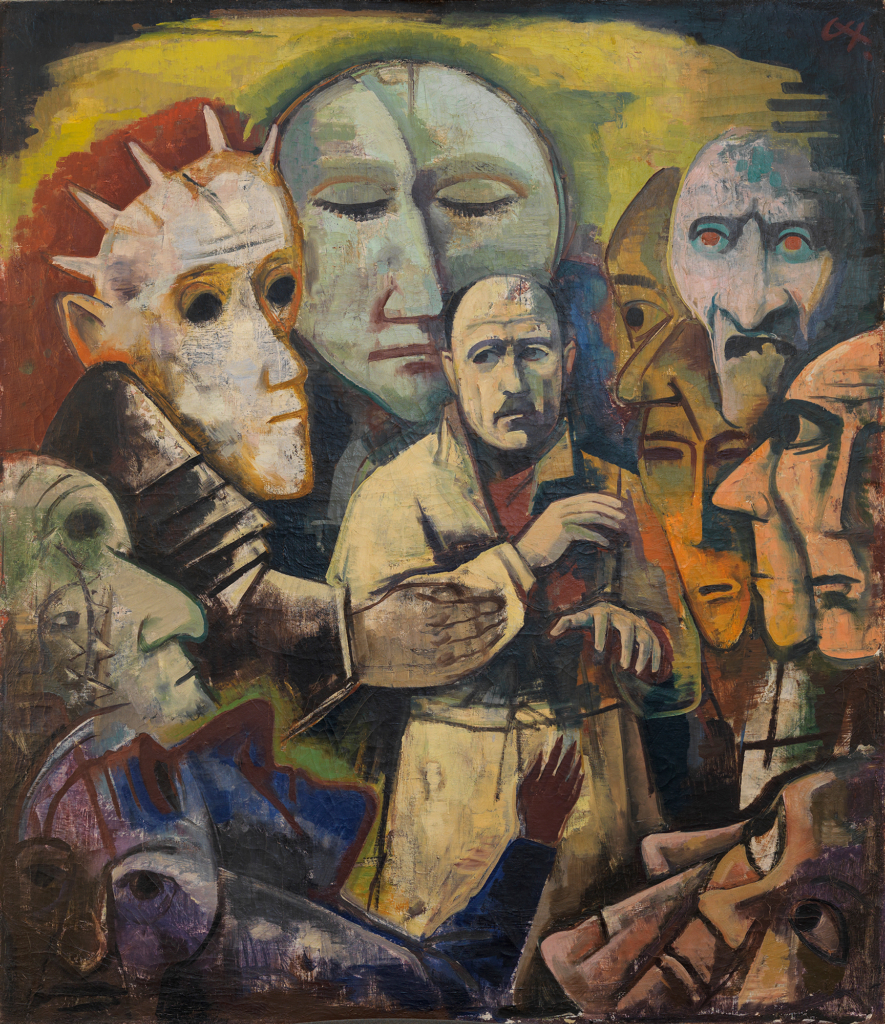
| X (Twitter) | |
|---|---|
URL kopieren
Die URL wurde erfolgreich kopiert und befindet sich in der Zwischenablage |
|
Aus urheberrechtlichen Gründen können wir die Werkabbildung leider nicht zum Download bereitstellen.
Hier erfahren Sie mehr.Self Portrait with Demons
Carl Hofer (1878)
H 120cm W 140.5cm
1922/23
KunsthalleKarlsruhe@ZKM
Provenance Studies
0:00
0:00
Carl Hofer for himself wearing a white coat is the central figure in this painting. Crowding him from all sides a garishly coloured mask like beings. The painter wards off the apparent threat with a defensive gesture. It’s an uncanny self-portrait a picture that can also tell a dramatic story.
The collection of modern art of the Kunsthalle started relatively late not until 1920 when Willy Storck was appointed director of the museum. You can see him on your screen now. One of his early pronouncedly modern acquisitions was Carl Hofers self-portrait with demons. The young director was able to purchase the painting directly from the artist studio in 1922.
From 1934 Kurt Martin was the director of the Kunsthalle. He was a friend of Carl Hofer and an admirer of his painting. Yet in 1936 he described the self-portrait with demons towards the Ministry of Education and Cultural Affairs as a bad buy that couldn’t be exhibited. In this way he was able to exchange it for thematically less offensive landscape painting by Carl Hofer entitled: Road to Lugano.
At this point in time the artist had long since been banned from painting by the Nazi regime and his art prescribed as degenerate. Considering Kurt Martins close association with Hofer and knowing as we do now how much he admired his art his official pronouncement about the self-portrait should presumably be seen as a tactical move. He probably hoped that a landscape painting would be more likely to escape the inevitable raids by the national socialists then the representation of a modern artist being threatened by imagined monsters. But in 1937 even the substituted landscape painting fell victim of the Nazis campaign against degenerate art.
The collection of modern art of the Kunsthalle started relatively late not until 1920 when Willy Storck was appointed director of the museum. You can see him on your screen now. One of his early pronouncedly modern acquisitions was Carl Hofers self-portrait with demons. The young director was able to purchase the painting directly from the artist studio in 1922.
From 1934 Kurt Martin was the director of the Kunsthalle. He was a friend of Carl Hofer and an admirer of his painting. Yet in 1936 he described the self-portrait with demons towards the Ministry of Education and Cultural Affairs as a bad buy that couldn’t be exhibited. In this way he was able to exchange it for thematically less offensive landscape painting by Carl Hofer entitled: Road to Lugano.
At this point in time the artist had long since been banned from painting by the Nazi regime and his art prescribed as degenerate. Considering Kurt Martins close association with Hofer and knowing as we do now how much he admired his art his official pronouncement about the self-portrait should presumably be seen as a tactical move. He probably hoped that a landscape painting would be more likely to escape the inevitable raids by the national socialists then the representation of a modern artist being threatened by imagined monsters. But in 1937 even the substituted landscape painting fell victim of the Nazis campaign against degenerate art.
In 1936 the self-portrait with demons went back to Hofer and remained with the family even after his death. In 1955 after an intermediate stay with a private collector in Stuttgart it was purchased by Bernd Schultz, the owner of the gallery Pels Leusden in Zurich. From there it was acquired by the Kunsthalle in 2018 returning after a long absence to its original home in the museum.
The case of the Hofer painting is different from that of most of the other works on this tour because the self-portrait with demons is not Nazi confiscated cultural property but a work that the museum chose to acquire and then relinquished of its own initiative. This shows how pictures can also tell stories of appreciation and depreciation in changing political contexts. Today the self-portrait with demons is the key work among the group of 12 Carl Hofer paintings in the Kunsthalle collection
Dates and facts
| Title | Self Portrait with Demons |
|---|---|
| Artist | Karl Hofer (1878) |
| Date | 1922/23 |
| Measurements Painting | H 140.5cm W 120cm |
| Material | Oil on canvas |